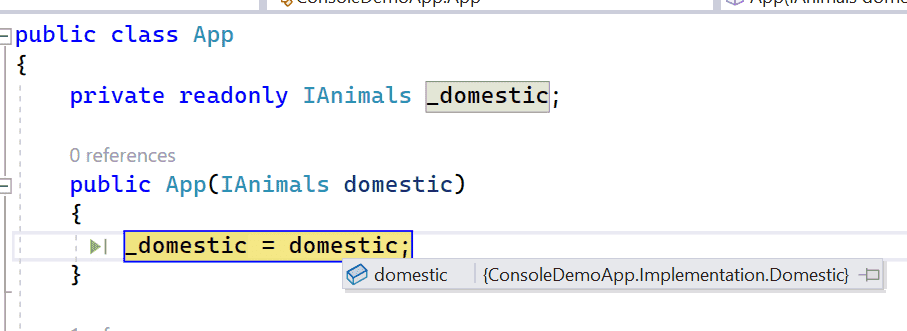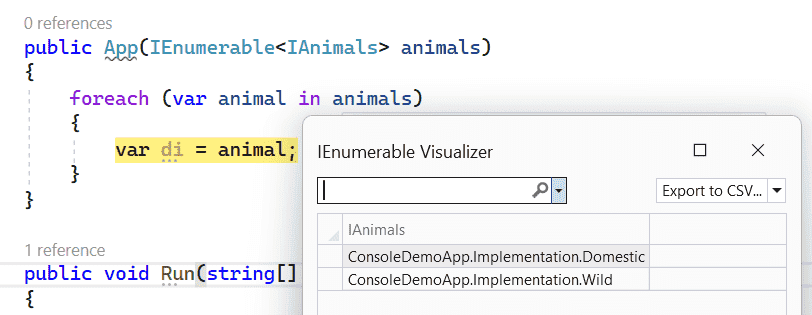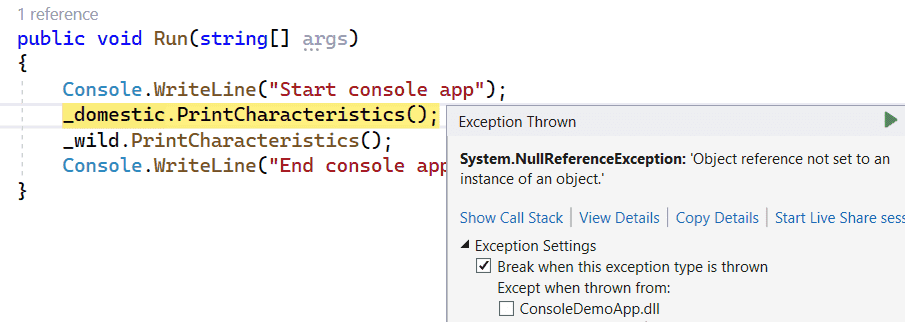- Published on ·
- Reading time 10 min read
How To Use Multiple Implementations of an Interface in .NET Core?
Registering and retrieving multiple implementations from the IoC container
Share this page

Introduction
Dependency injection is built into ASP.NET Core allowing developers to achieve Inversion of Control (IoC) between classes and their dependencies. Normally, if class A calls a method on class B, class A has a direct dependency on class B. But with inversion of control, class A calls methods on an abstraction that B implements, thus only loosely coupling the two classes, unlike direct dependency which was tightly coupling the two.
Inverting the dependency helps at compile time. The exact dependency class B doesn't need to be coded into class A, if class B depends on more classes, that doesn't need to be manually added in class A, and because of an abstract dependency on class B, writing unit tests and mocking class B in unit tests becomes easier. At runtime, though, things remain unchanged, class A still calls B.
This works great when a single concrete class implements an interface and is then injected into dependent classes. But it's only when you introduce multiple implementations of the same interface into dependency injection that we start noticing an issue.
In this article, we'll take a look at how we arrive at the problem and then how we might go about solving it and retrieving a specific service from the container. The complete source code for the example used in this article can be found in this GitHub repository. And under each step of this article, you'll find a link to the specific changeset from this repository that reflects the example project at that step, in case you'd like to closely follow.
Single implementation
If you'd like to follow along, you can view the GitHub code repository as it was when this step was implemented.
We'll start with a simple console app, then add an interface and a single concrete class that implements the interface. You can recreate the specifics as per your liking, but if you'd like to follow the main App.cs file code snippet is below.
using ConsoleDemoApp.Interface;
namespace ConsoleDemoApp;
public class App
{
private readonly IAnimals _domestic;
public App(IAnimals domestic)
{
_domestic = domestic;
}
public void Run(string[] args)
{
Console.WriteLine("Start console app");
_domestic.PrintCharacteristics();
Console.WriteLine("End console app");
}
}
And in the Program.cs file, we'll register our dependencies.
using ConsoleDemoApp;
using ConsoleDemoApp.Implementation;
using ConsoleDemoApp.Interface;
using Microsoft.Extensions.DependencyInjection;
using Microsoft.Extensions.Hosting;
using IHost host = CreateHostBuilder(args).Build();
using var scope = host.Services.CreateScope();
var services = scope.ServiceProvider;
try
{
services.GetRequiredService<App>().Run(args);
}
catch (Exception e)
{
Console.WriteLine(e.Message);
}
IHostBuilder CreateHostBuilder(string[] strings)
{
return Host.CreateDefaultBuilder()
.ConfigureServices((_, services) =>
{
services.AddScoped<IAnimals, Domestic>();
services.AddSingleton<App>();
});
}
When we run this console app, it prints the message from the concrete implementation.

Image courtesy of the author
If I add a breakpoint, it's evident that the registration of the dependency in the service container is done correctly and the injection of the dependency into the constructor of the class where it's used is also done correctly. The .NET framework will also take care of disposing of the injected dependency when it's no longer needed.

Image courtesy of the author
Easy peasy so far? Good! For the rest of this article, we'll build on this codebase.
Multiple implementations
If you'd like to follow along, you can view the GitHub code repository as it was when this step was implemented.
Let's extend the single implementation example and add another concrete class that implements IAnimals. I've added this additional dependency to the constructor of the App class and also made use of this new dependency in the Run method.
using ConsoleDemoApp.Interface;
namespace ConsoleDemoApp;
public class App
{
private readonly IAnimals _domestic;
private readonly IAnimals _wild;
public App(IAnimals domestic, IAnimals wild)
{
_domestic = domestic;
_wild = wild;
}
public void Run(string[] args)
{
Console.WriteLine("Start console app");
_domestic.PrintCharacteristics();
_wild.PrintCharacteristics();
Console.WriteLine("End console app");
}
}
Don't forget to register this dependency with the service container in the Program class file. When we run this application, what do you think the output will be?
IHostBuilder CreateHostBuilder(string[] strings)
{
return Host.CreateDefaultBuilder()
.ConfigureServices((_, services) =>
{
services.AddScoped<IAnimals, Domestic>();
services.AddScoped<IAnimals, Wild>();
services.AddSingleton<App>();
});
}
When we actually run the console app, you'll see duplicate messages printed on the console. This is because the last dependency in the constructor list in the App class is what overrides all dependencies of the type IAnimals.

Image courtesy of the author
If we put a breakpoint in the constructor, we can see that both domestic and wild have the same implementation Wild injected into it.

Image courtesy of the author
How to fix this?
To resolve this issue, we'll replace the individually added dependencies with an IEnumerable list. This list will hold all the dependencies injected for the type IAnimals. We can simply put a foreach loop to see this in action.
using ConsoleDemoApp.Interface;
namespace ConsoleDemoApp;
public class App
{
public App(IEnumerable<IAnimals> animals)
{
foreach (var animal in animals)
{
animal.PrintCharacteristics();
}
}
}
If you'd like to follow along, you can view the GitHub code repository as it was when this step was implemented.
If you put a breakpoint and visualize the animals list in the code snippet, you'll see both concrete implementations in the list.

Image courtesy of the author
So technically, if all you wanted was to print a message from both implementations without worrying about the order, then this would be okay. As pictured below, both messages are printed, although before the messages from the Run method is executed.

Image courtesy of the author
Reassigning dependencies
If you'd like to follow along, you can view the GitHub code repository as it was when this step was implemented.
Just looping through a foreach loop doesn't give us enough flexibility. What we need is to reassign these dependencies so we can use them individually.
Notice how the foreach loop looks like in the code snippet below. During each loop, we're checking the type of the current dependency, and then with the help of the GetService method from IServiceProvider, we're resolving the service and assigning it to a local private variable. The little exclamation mark at the end is a null-forgiving operator which tells the compiler that this isn't going to be null.
using ConsoleDemoApp.Implementation;
using ConsoleDemoApp.Interface;
using Microsoft.Extensions.DependencyInjection;
namespace ConsoleDemoApp;
public class App
{
private readonly IAnimals _domestic;
private readonly IAnimals _wild;
public App(IEnumerable<IAnimals> animals, IServiceProvider serviceProvider)
{
foreach (var animal in animals)
{
if (animal.GetType() == typeof(Domestic))
_domestic = serviceProvider.GetService<Domestic>()!;
if (animal.GetType() == typeof(Wild))
_wild = serviceProvider.GetService<Wild>()!;
}
}
public void Run(string[] args)
{
Console.WriteLine("Start console app");
_domestic.PrintCharacteristics();
_wild.PrintCharacteristics();
Console.WriteLine("End console app");
}
}
The IServiceCollection interface is used for building a dependency injection container, and after it's fully built, it gets composed into an IServiceProvider instance which you can inject into any class and use to resolve services.
Because we're assigning each resolved service into its own variable, we can now independently use that to perform functions with it, like printing the messages from these concrete classes in the right places of the console app. But wait, when I run the application, I get a null reference exception!

Image courtesy of the author
If I add a breakpoint to the constructor, you can see that although the animals list has both concrete implementations injected into it, the assigned variables _domestic and _wild is still null. This means that the service provider's GetService method isn't doing its magic.

Image courtesy of the author
What did we miss? Ah, we did not individually register these services in the service container in the Program class file. We've now added them in lines 9 and 10 in the code snippet below. Without this explicit registration, the service collection would've only contained a registration for IAnimals and not for Domestic or Wild.
IHostBuilder CreateHostBuilder(string[] strings)
{
return Host.CreateDefaultBuilder()
.ConfigureServices((_, services) =>
{
services.AddScoped<IAnimals, Domestic>();
services.AddScoped<IAnimals, Wild>();
services.AddScoped<Domestic>(); // Add this
services.AddScoped<Wild>(); // Add this
services.AddSingleton<App>();
});
}
Now if I run the application with the breakpoints, I can verify that the assignments have worked correctly.

Image courtesy of the author
And the output in the console application is printed correctly, too!

Image courtesy of the author
Moving this logic up
If you'd like to follow along, you can view the GitHub code repository as it was when this step was implemented.
Rather than writing if conditions in the consuming App class, let's move the logic into the Program class file where we're registering the dependencies.
So, we'll leave the individually registered services in the file, lines 7 and 8 in the code snippet below. Next, to register an implementation with the type IAnimals, we'll write a Func<T,TResult> delegate. The body of this method has a simple switch statement that returns the service depending on what type is passed, very similar to the if conditions in the foreach loop seen earlier. AnimalTypes is a simple enum with Domestic and Wild as its enum members.
IHostBuilder CreateHostBuilder(string[] strings)
{
return Host.CreateDefaultBuilder()
.ConfigureServices((_, services) =>
{
services.AddScoped<Domestic>();
services.AddScoped<Wild>();
services.AddTransient<Func<AnimalTypes, IAnimals>>(serviceProvider => serviceTypeName =>
{
switch (serviceTypeName)
{
case AnimalTypes.Domestic:
return serviceProvider.GetService<Domestic>()!;
case AnimalTypes.Wild:
return serviceProvider.GetService<Wild>()!;
default:
return null;
}
});
services.AddSingleton<App>();
});
}
Because we're resolving the service instance at runtime, we're registering this using the AddTransient method. A quick refresher, when a service is configured as transient, a new instance of that service is created every time it's needed. While, on the other hand, when a service is configured as scoped, a single instance of that service is created for the duration of an operation of request.
We can now go back to the App class file and replace the constructor bit to accept this function delegate and then use that method and pass in the required enum type to return the correct service instance.
public class App
{
// The only change is in the constructor. Rest remains the same.
public App(Func<AnimalTypes, IAnimals> serviceResolver)
{
_domestic = serviceResolver(AnimalTypes.Domestic);
_wild = serviceResolver(AnimalTypes.Wild);
}
}
In a real scenario, though, if you're using dynamic service registration, it's very likely you wouldn't know what type would this class need, and hence you wouldn't end up hardcoding like we did in the example above. But since this is an example for the purpose of elaborating a concept, it's fine to leave this as-is.
Anyway, running our console application now gives us the console output we were expecting, so yay!

Image courtesy of the author
Once again, the complete source code used in this article can be found in this GitHub repository. If you have any questions, feel free to comment below.
That's it! Thanks for reading.